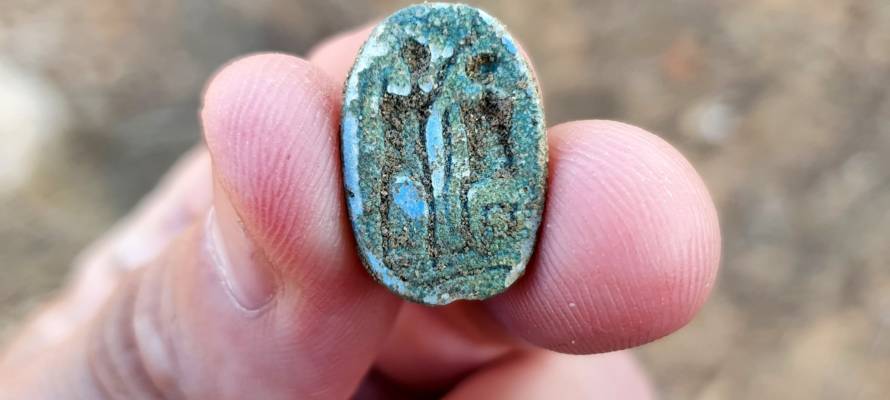“At first, I thought it was a toy lying in the dirt, but an inner voice said to me: ‘Pick it up and turn it over!’” explained Gilad Stern of the Israel Antiquities Authority Educational Center.
By United with Israel Staff
This week, Israeli students on an archaeological tour in Azor, near Tel Aviv, discovered a 3,000-year-old scarab.
“At first, I thought it was a toy lying in the dirt, but an inner voice said to me: ‘Pick it up and turn it over!’ I was astonished! It was a scarab seal with a clearly inscribed scene—every archaeology-lover’s dream,” explained Gilad Stern of the Israel Antiquities Authority (IAA) Educational Center, who led the tour.
“The scene depicted on the scarab probably represents the bestowing of legitimacy on a local ruler,” explained a statement from the IAA. The scarab is in the shape of a dung beetle, a prominent symbol in ancient Egypt representing “creation and regeneration,” explained the IAA, because of the insect’s key activity: “roll[ing] a ball of dung twice its size where it stows its future offspring.”
The eighth-graders arrived in Azor from the Rabin Middle School as part of an IAA tour guide course in which pupils teach local residents about the archaeological heritage of the area.
“The scarab was used as a seal and was a symbol of power and status. It may have been placed on a necklace or a ring. It is made of faience, a silicate material coated with a bluish-green glaze. It may have dropped from the hands of an important and figure of authority who passed through the area, or it may have been deliberately buried in the ground along with other objects, and after thousands of years it came to the surface. It’s difficult to determine the exact original context,” explained Dr. Amir Golani, IAA Bronze Age specialist.
“This scene basically reflects the geopolitical reality that prevailed in the land of Canaan during the Late Bronze Age (ca. 1500-1000 BCE), when the local Canaanite rulers lived (and sometimes rebelled) under Egyptian political and cultural hegemony,” added Golani. “Therefore, it is very possible that the seal is indeed from the Late Bronze Age, when the local Canaanites were ruled by the Egyptian Empire.”
To date, hundreds of scarabs have been discovered in the Land of Israel, in both graves and within settlement layers. While some may have been Egyptian imports, others appear to be produced by local artisans.
According to the IAA, “The level of workmanship of the particular scarab found [in Azor this week] is not typical for Egypt and may represent a product of local craftsmen.”
Azor sits about 15 miles southeast of Tel Aviv, Israel.
